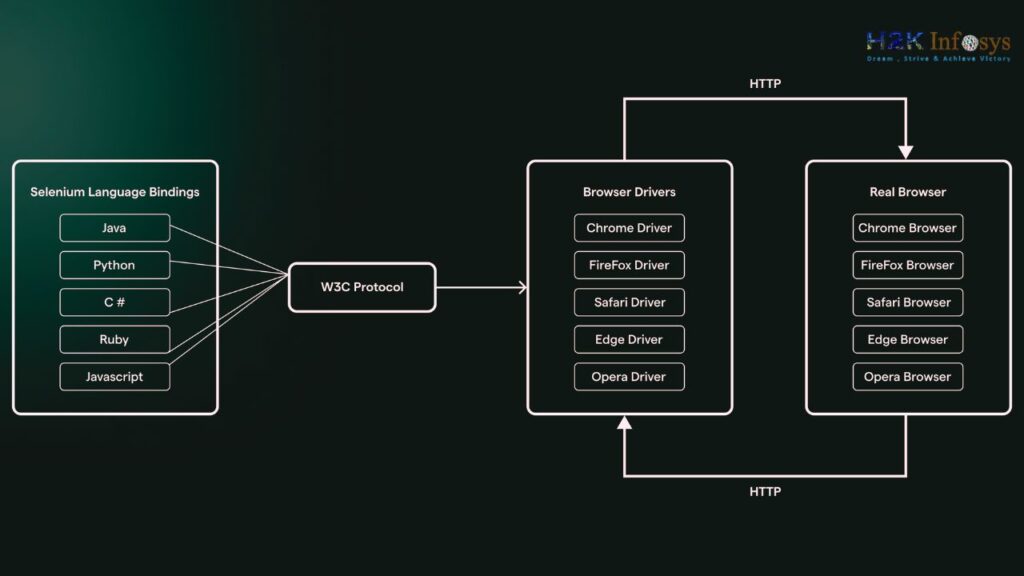Selenium has been a leading tool for automation testing for many years, with Selenium WebDriver being its most popular component. As the demands for more efficient and comprehensive testing grow, Selenium has continued to evolve, culminating in the release of Selenium 4. If you’re familiar with Selenium 3 or considering diving into a Selenium training, understanding the differences between Selenium 3 and Selenium 4 is crucial. This guide will walk you through the key changes and improvements, helping you maximize your Selenium automation skills.
Understanding Selenium WebDriver
Before diving into the differences, it’s essential to understand what Selenium WebDriver is and why it plays a critical role in automation testing.
What is Selenium WebDriver?
Selenium WebDriver is a core component of the Selenium framework that allows testers to automate browser actions. It directly communicates with the browser, simulating user interactions like clicking, typing, and navigating web pages. This makes it a powerful tool for automated testing of web applications, ensuring that they function correctly across different browsers and devices.
Key Features of Selenium WebDriver:
- Cross-Browser Testing: Supports all major browsers like Chrome, Firefox, Edge, and Safari.
- Language Flexibility: Allows writing test scripts in multiple programming languages such as Java, Python, C#, and JavaScript.
- Integration: Easily integrates with various testing frameworks and CI/CD pipelines.
- Automation of User Actions: Automates common user actions such as clicking buttons, filling out forms, and navigating web pages.
Selenium 3 Overview
Selenium 3, released in 2016, brought significant updates from its predecessor, Selenium 2, mainly focusing on enhancing the existing WebDriver APIs. It retained many familiar functionalities while laying the groundwork for more advanced features.
Key Features of Selenium 3:
- Browser Compatibility: Enhanced support for modern browsers and removed the dependency on legacy browsers.
- Updated WebDriver APIs: Improved stability and performance of WebDriver.
- W3C WebDriver Protocol (Partial): Began the transition to W3C WebDriver Protocol, aiming for better cross-browser compatibility.
- Improved Grid: Selenium Grid in Selenium 3 allowed for more efficient parallel test execution but required manual setup.
Selenium 4 Overview
Selenium 4, officially released in 2021, builds upon the strengths of Selenium 3 and introduces significant new features and updates aimed at modernizing the tool. It fully implements the W3C WebDriver Protocol, providing a more stable and reliable automation experience across different browsers.
Key Features of Selenium 4:
- Full W3C WebDriver Protocol: Complete implementation, enhancing browser compatibility and reducing inconsistencies.
- Improved Selenium Grid: New features for better scalability, simplified setup, and support for Docker.
- New Relative Locators: Easier element location using nearby elements.
- Enhanced Documentation: Improved and more accessible documentation for users.
- Better Developer Tools Integration: Direct access to browser development tools, enhancing debugging capabilities.
Comparing Selenium 3 vs Selenium 4
Let’s explore the key differences between Selenium 3 and Selenium 4 across various aspects, highlighting how Selenium 4 has advanced the automation landscape.
W3C WebDriver Protocol Implementation
- Selenium 3:
- Selenium 3 introduced partial support for the W3C WebDriver Protocol, but it still relied heavily on the JSON Wire Protocol for communication between WebDriver and browsers. This often led to inconsistencies and compatibility issues across different browsers.
- Selenium 4:
- Selenium 4 fully implements the W3C WebDriver Protocol, which has now become the industry standard. This transition ensures more reliable and consistent browser automation, reducing the chances of unexpected behaviors and errors. Selenium 4’s adherence to this protocol enhances compatibility and simplifies WebDriver commands.
Selenium Grid Enhancements
- Selenium 3:
- Selenium 3’s Grid required manual configuration and setup, which could be complex and time-consuming. While it allowed parallel test execution, scaling the grid required significant effort.
- Selenium 4:
- Selenium 4 introduces a revamped Selenium Grid with a modern user interface and a simplified setup process. It supports Docker, making it easier to scale up or down based on testing needs. The new Grid also includes observability features, allowing testers to monitor and debug tests more effectively, enhancing overall test management.
Relative Locators
- Selenium 3:
- Selenium 3 did not have built-in relative locators, making it challenging to locate elements based on their position relative to other elements. Testers often had to rely on complex XPath expressions or additional tools.
- Selenium 4:
- Selenium 4 introduces Relative Locators (formerly called Friendly Locators), which allow you to find elements relative to other elements on the page. For example, you can locate an element “above,” “below,” “to the left of,” “to the right of,” or “near” another element. This feature simplifies element location, especially in dynamic web pages.
javaWebElement loginButton = driver.findElement(RelativeLocator.with(By.tagName("button")).below(By.id("password")));Improved Developer Tools Integration
- Selenium 3:
- Selenium 3 provided basic integration with browser developer tools, but it lacked direct access to functionalities like capturing network logs, performance data, and debugging.
- Selenium 4:
- Selenium 4 offers enhanced integration with browser developer tools, including the ability to capture network logs, and performance metrics, and simulate different network conditions. This deeper integration aids in debugging and analyzing the behavior of web applications under test.
Improved Documentation and Support
- Selenium 3:
- While Selenium 3 had adequate documentation, it often required users to look up external resources or community forums for complex troubleshooting.
- Selenium 4:
- Selenium 4 comes with enhanced documentation that is more structured and accessible, making it easier for beginners and experienced users alike. The updated guides, tutorials, and examples help users quickly understand and implement new features.
Browser Support and Driver Management
- Selenium 3:
- Selenium 3 relied on manually downloading and managing browser drivers, which could lead to version mismatches and compatibility issues.
- Selenium 4:
- Selenium 4 simplifies driver management with the introduction of WebDriverManager, which automatically manages browser drivers, ensuring that the correct version is used for your tests. This reduces setup time and minimizes errors related to driver mismatches.
Enhanced Performance and Stability
- Selenium 3:
- While Selenium 3 was stable, it sometimes suffered from performance lags, especially when dealing with complex web applications or executing parallel tests on large grids.
- Selenium 4:
- Selenium 4 brings performance improvements across the board, thanks to better WebDriver protocols, optimized grid management, and efficient driver handling. These enhancements result in faster test execution and more reliable test outcomes.
Why Upgrade to Selenium 4?
If you are currently using Selenium 3 or planning to enroll in a Selenium automation testing course, upgrading to Selenium 4 is highly recommended. Here’s why:
Benefits of Upgrading to Selenium 4:
- Improved Browser Compatibility: Full W3C WebDriver support ensures consistent behavior across all supported browsers.
- Simplified Test Management: The new Selenium Grid offers an intuitive UI and better scalability options, making it easier to manage tests.
- Advanced Element Location: Relative locators provide a more flexible and intuitive way to interact with elements on the page.
- Better Debugging Tools: Integration with developer tools offers enhanced debugging capabilities, helping you quickly identify and fix issues.
- Enhanced Documentation: Comprehensive and updated resources make learning and implementing Selenium 4’s features straightforward.
How to Upgrade from Selenium 3 to Selenium 4
Upgrading to Selenium 4 is relatively straightforward, but you need to make sure your project dependencies are updated accordingly. Here are the steps:
- Update Selenium WebDriver Dependencies:
- For Maven projects, update the Selenium dependencies in your
pom.xmlfile to the latest Selenium 4 version.
- For Maven projects, update the Selenium dependencies in your
xml<dependency> <groupId>org.seleniumhq.selenium</groupId> <artifactId>selenium-java</artifactId> <version>4.0.0</version> </dependency>- Update Browser Drivers:
- Ensure your browser drivers are updated to versions compatible with Selenium 4. Using the WebDriverManager will handle this automatically.
- Test Your Existing Scripts:
- Run your existing Selenium scripts to identify any issues that may arise due to deprecated methods or new behaviors introduced in Selenium 4.
- Modify Scripts for New Features:
- Refactor your scripts to take advantage of Selenium 4’s new features, such as relative locators and direct developer tools access.
Should Beginners Start with Selenium 3 or Selenium 4?
When starting with Selenium, beginners often wonder whether to learn Selenium 3 or the latest Selenium 4. The answer depends on factors like industry trends, feature updates, and long-term usability.
Why Choose Selenium 4?
Selenium 4 is the latest version and comes with significant improvements, making it the best choice for beginners. It introduces enhanced WebDriver APIs, better browser support, and native Chrome DevTools Protocol (CDP) integration. These updates make test automation more efficient and future-proof. Learning Selenium 4 ensures that beginners stay up to date with industry standards and avoid learning outdated techniques.
Is Selenium 3 Still Relevant?
Selenium 3 is still widely used in many organizations, but it lacks the modern features of Selenium 4. If a project or company still relies on Selenium 3, learning it might be necessary. However, for new learners, it is more beneficial to start directly with Selenium 4.
Beginners should focus on Selenium 4 to gain expertise in the latest automation tools and stay ahead in their careers. However, understanding Selenium 3 can be useful when working with legacy projects. Ultimately, starting with Selenium 4 ensures better job opportunities and long-term relevance.
Conclusion
Selenium 4 brings a host of improvements and new features that make automation testing more efficient, reliable, and accessible. By fully embracing the W3C WebDriver Protocol, enhancing Selenium Grid, and introducing new tools like relative locators, Selenium 4 significantly advances the capabilities of Selenium WebDriver.
Whether you are a seasoned tester or a newcomer enrolled in a Selenium training online, transitioning to Selenium 4 will equip you with the tools needed to excel in the fast-evolving field of software testing. Embrace these changes to stay ahead of the curve and ensure your automation skills remain in high demand.
Elevate your expertise with H2K Infosys, where industry experts guide you through real-world applications of Selenium in automation testing. With flexible learning options, practical projects, and dedicated job placement support, you’ll be well-prepared to excel in your career. Enroll today and master the transition from Selenium 3 to Selenium 4 with confidence!





























